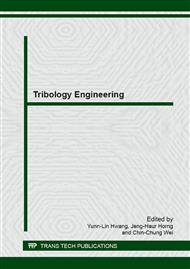p.30
p.34
p.39
p.45
p.50
p.55
p.60
p.66
p.72
Friction and Wear Characteristics of Hydrogenated and Hydrogen-Free DLC Coatings when Lubricated with Biodegradable Vegetable Oil
Abstract:
Large amount of unsaturated and polar component of oils enhance the lubrication of ferrous materials. DLC coatings can effectively lower the coefficient of friction (CoF) and wear rate of engine components, consequently improving the fuel efficiency and durability of these components. Therefore, the interaction between nonferrous coatings (e.g., DLC) and vegetal oil must be investigated. A ball-on-plate tribotester was used to run the experiments using stainless steel plates coated with amorphous hydrogenated (a-C:H) DLC and hydrogen-free tetrahedral (ta-C) DLC sliding against 440C stainless steel ball. Raman analysis was performed to investigate the structural change of the coatings. At high temperatures, the CoF decreases in both coatings but the wear rate increases in the a-C:H and decreases in the ta-C DLC-coated plates. CoF and wear rate (coated layer and counter surface) are mostly influenced by coating graphitization. The degree of graphitization increases with increasing temperature. Graphitization occurs in the tribological contact because of friction-induced heating under contact and high contact stress conditions.
Info:
Periodical:
Pages:
50-54
Citation:
Online since:
April 2015
Authors:
Keywords:
Price:
Сopyright:
© 2015 Trans Tech Publications Ltd. All Rights Reserved
Share:
Citation:


